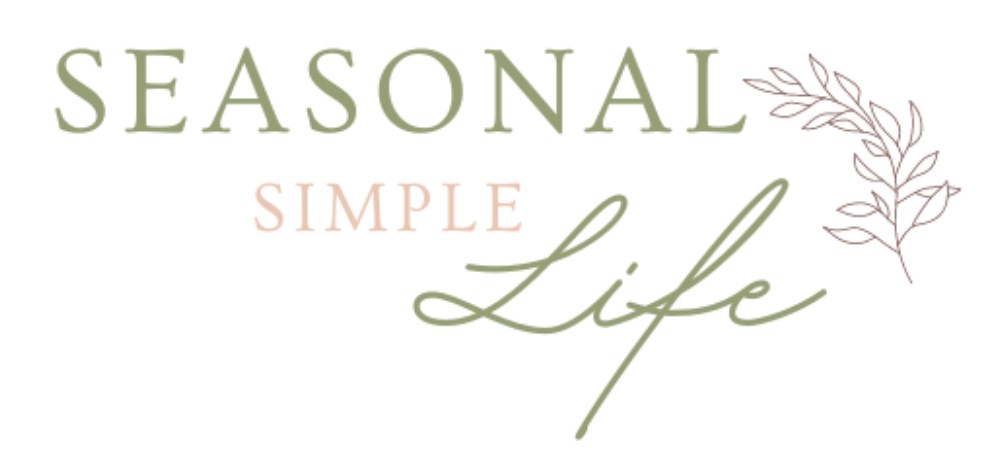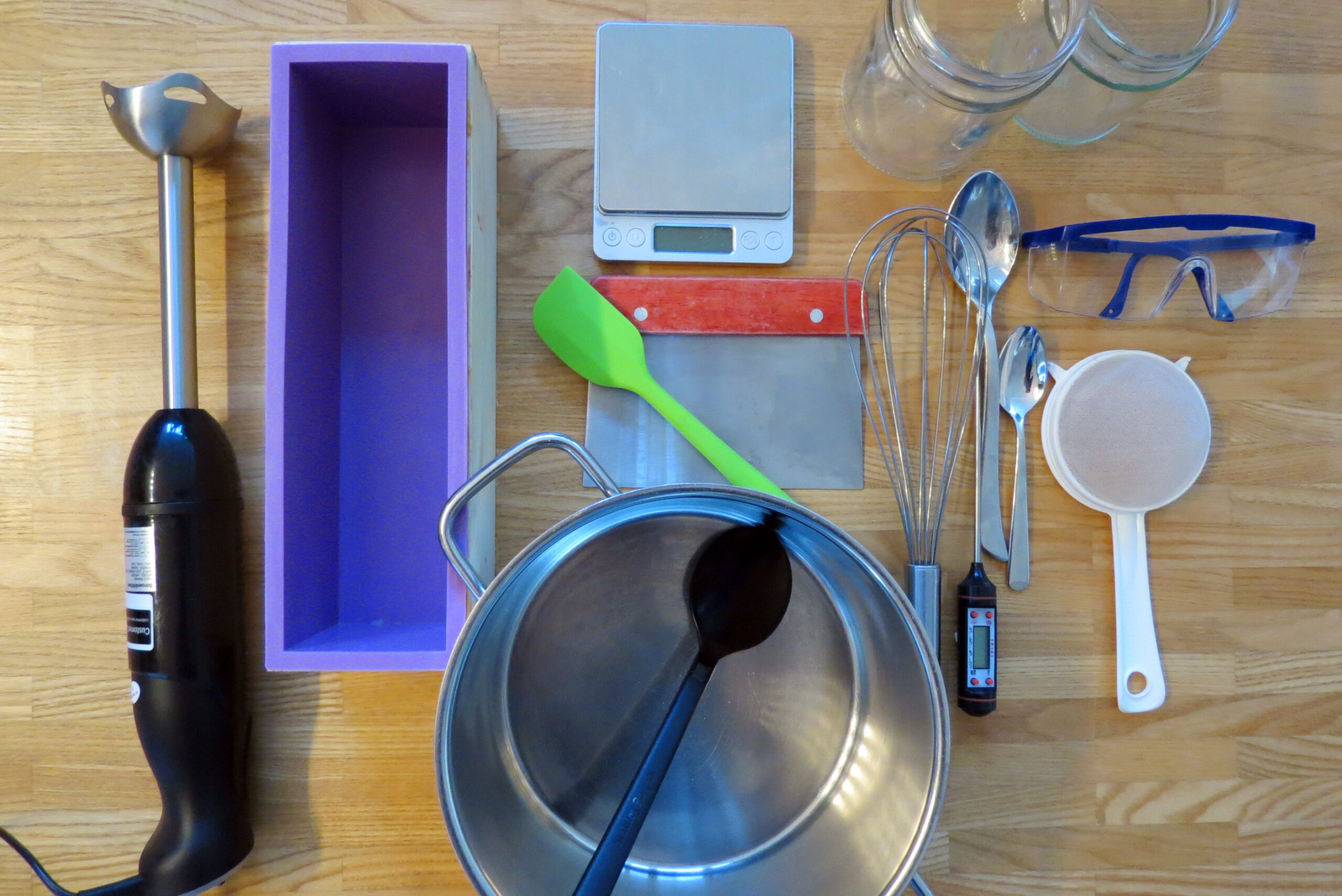.
To start with soapmaking, you only need some basic soapmaking equipment. Later, when you are infected with the soapmaking virus, you can always buy additional tools that’ll make the process easier and allow you to make more elaborate designs.
When looking for equipment, take its durability and safety into consideration. Wooden tools are not a good choice, for example, as they are damaged by the lye. The same applies for all things aluminium. Never use anything made from aluminium when making soap as it reacts with lye! It’ll not only ruin your soap but will also form hydrogen, a toxic and explosive gas.
Checklist for your soapmaking equipment

Safety equipment
- Chemical-resistant gloves, like medical disposable gloves or rubber dishwashing gloves.
- Safety goggles that cover the whole eye (and glasses if you wear them); alternatively, you can wear a face shield.
- Breathing mask to avoid breathing in any lye dust or toxic gasses that form when the lye is added to the water.
To become familiar with the safety guidelines for soapmaking, hop over here and carefully read this article.
Bowls and tools
Scale
All ingredients in soapmaking are measured by weight, not by volume as weight is more precise and precision is essential in soapmaking. Digital scales work best, but manual models are also ok. Choose a scale that can hold enough amounts for soapmaking.
Cups and spoons
Cups are great for colouring small portions of soap batter and as a design tool, especially when they have spouts.
Measuring spoons are useful for precision when it comes to dry additives like colourants, clays or exfoliants.
Also, you need one long-handled spoon for creating designs.
Lye-water container
Use a heat-resistant bowl with a handle and preferably a spout. Choose a large enough container as it is important to have plenty of headspace when mixing lye-water.
Bowls
Use heat- and chemical-resistant plastic, glass or stainless steel bowls for mixing the soap batter. Two or three bowls that are large enough for different soap batches (including extra room) are ideal. Additionally, containers with a handle and a spout make it a good deal easier to pour the batter into the mould or create certain techniques.
Thermometer
You need two thermometers (100 °C) to measure the temperatures of oils and lye-water. Lab thermometers are as suitable as candy or digital thermometers.
Whisks, spatula and blender
Whisks in different sizes are great for mixing fragrance oils and other additives into the soap batter. They are also useful for maintaining the appropriate trace as you work. Stainless steel is ideal.
Spatulas are used to scrape the last batter of soap out of the bowl and create certain designs. They should be made from silicone or heavy-duty rubber.
A stick blender is a useful tool that’s almost essential for modern soapmaking. It reduces the tracing process from a 30- to 90-minute process to just a few minutes- When buying a stick blender, look for a model that will not whip much air into the soap batter and has a stainless steel shaft. If you can detach the shaft from the electrical unit, it’s easier to clean.
Other useful equipment
These items aren’t critical for soapmaking but they make the process easier and more convenient.
- Rubbing (isopropyl) alcohol to spray on the surface of the soap to prevent the formation of soda ash.
- Plastic squirt bottles are used for certain designs, like swirling or multi-layers.
- Mini mixer (mini milk frother) for mixing colourants and clays with oil.
- Pipette for precisely measuring fragrance and essential oils
Soapmaking Equipment: Moulds
There are so many options when it comes to moulds for soapmaking: you can make your own out of milk containers, boxes lined with freezer paper and beverage cartons. You can use common kitchen containers (Tupperware) or mini cake moulds (like muffin moulds in different shapes and sizes). Or you can buy moulds made of wood, silicone or plastic that are made specially for soapmaking.
DIY moulds
When you are new to soapmaking, you needn’t buy a soap mould but you can always “misuse” items you already have. Just keep in mind that once used for soapmaking, these items mustn’t be used for food ever again. The second thing is to make sure that the soap batter doesn’t come into contact with aluminium.
Glass and metal are not optimal as it will be nearly impossible to remove the soap from the mould
The following things can be used as soap moulds:
- Waxed cardboard milk and juice cartons
- Empty potato chip tubes
- PVC tubes, washed out and dried; fix one end either with a plastic lid or multiple layers of duct tape
- Cake moulds: best are those made of silicone. If you have cake moulds made of metal, layer them with cling film so that the soap batter doesn’t come into contact with the metal
- Plastic containers like yoghurt cups, Tupperware etc. You may want to grease them before filling in the soap batter
- Wooden moulds; you always have to line wooden moulds with freezer paper
I’m sure there are many more options. Be creative!
Standard moulds
There are great soap moulds in many different sizes, shapes and materials on the market. The most common materials for moulds are silicone, plastic and wood.
Depending on the techniques you want to carry out in your soapmaking process, you can either use log moulds, slab moulds or silicone moulds.
Needless to say, you can also buy special moulds with which you can make very special forms. Often, they’re made of heavy-duty plastic and the removal of the soap can be challenging. It’s therefore best to use a recipe for a comparatively hard soap for this kind of mould.
Conclusion
You see, despite needing some basic equipment, there’s no need to go overboard when starting with soapmaking. Most things you’ll already have and nothing prevents you from using for example a stick blender you already have – as long as from now on you’ll use it for soapmaking only! You should invest in good safety goggles that protect your eyes from lye splashes but other than that, soapmaking equipment needn’t be expensive. After all, you can always add fancy equipment and moulds to your birthday wishlist.
Have fun getting started with soapmaking!


0 Comments